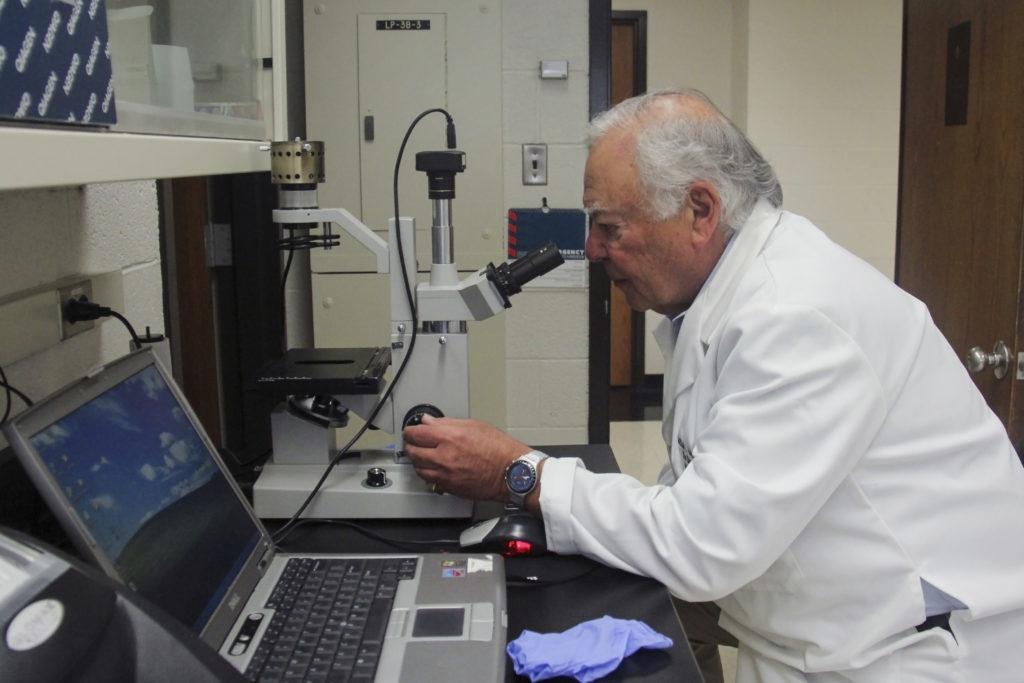Updated: April 25, 2017 at 2:38 p.m.
A medical school professor’s research project could change the way cystic fibrosis is treated worldwide.
Allan Goldstein, a professor emeritus of biochemistry and molecular biology in residence, and his team discovered that a special type of protein can be used to treat cystic fibrosis and is now working with researchers in Italy to start their first pilot clinical trial by the end of the year. Goldstein said the research could one day produce a relatively inexpensive drug to treat patients afflicted with the disease.
“Wouldn’t it be nice to not have to give these patients massive amounts of steroids and antibiotics and other medications?” Goldstein said in an email.
Cystic fibrosis is a potentially fatal hereditary disease that often leads to severe respiratory infections. The disease affects more than 30,000 people living in the United States, according to the Boomer Esiason Foundation – an organization that raises awareness of the disorder and support for a cure.
Goldstein began his research on cystic fibrosis almost five years ago. He said the research has focused on working with Thymosin alpha-1, a protein fragment that can be used to regulate the human immune system and combat cystic fibrosis.
Researchers conducted initial trials with animal models and patient cells before the treatment was tested on humans, he said. The first clinical trials of the treatment on cancer patients were completed in GW’s medicine department.
Goldstein worked with two other scientists in Italy: Luigina Romani, chair of the department of pathology at the University of Perugia, and Enrico Garaci, the rector – a term for the head of a university in Italy – and professor at the University of Rome, San Raffaele. He said Garaci is a colleague of his and that Romani had previously worked with Garaci.
Goldstein said Romani and Garaci received funding from the Italian Cystic Fibrosis Foundation to begin their research. The foundation provided some of the human cells they used to carry out initial tests and financial support for the scientists.
Goldstein said the research team also received help from scientists in Europe, like a group in the Netherlands that provided an animal model for testing.
The team first found that the protein fragment could impact the human immune system. But then, in a development that surprised even the researchers themselves, they discovered the same type of protein could repair a misfolded protein, which can result in cystic fibrosis. This discovery led researchers to pursue whether the protein would be an effective treatment for the disease, he said.
“When you’re doing a study and if you’re a good scientist, you look at everything else to see if there are any other effects,” Goldstein said.
Goldstein said the research team has started designing the first pilot clinical trial for this new drug. The trial will be held in Italy, where this type of treatment is already approved. Over the past two decades, this type of protein has proven to be a safe method of treatment for other diseases like lung cancer, he added.
The new treatment will first be tested in a clinical trial with an even mix of children and adults to find the “ideal dose” for treatment, he said.
Goldstein said the trial will last for about a month while researchers assess the effectiveness of the treatment.
“If everything goes well, they may be able to start clinical trials this year,” he said.
Goldstein said he hopes this research will allow cystic fibrosis to be treated with just one type of protein fragment at a relatively low cost.
Goldstein said when he first came to GW in the late 1970s, he published his first papers on research involving these types of protein fragments. He said he has been working in this line of research for the past 53 years, dating all the way back to his time as a postdoctoral fellow at Albert Einstein College of Medicine.
“This was my first child,” Goldstein said.
This post was updated to reflect the following corrections:
The Hatchet incorrectly reported the titles of Luigina Romani and Enrico Garaci. Romani is the chair of the department of pathology at the University of Perugia and Garaci is rector and professor at the University of Rome, San Raffaele. The Hatchet also incorrectly reported that Garaci is a former colleague of Goldstein. Garaci and Goldstein are still colleagues. The post was also updated to clarify that the first trials of thymosin alpha-1 specifically involving cancer patients took place within GW’s medicine department. We regret these errors.




